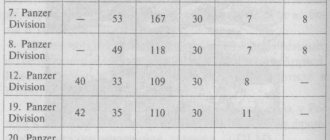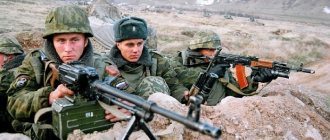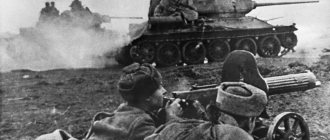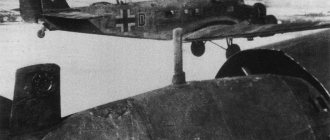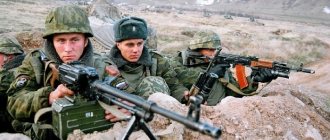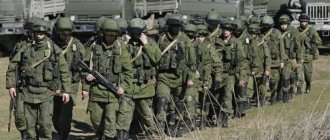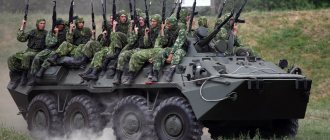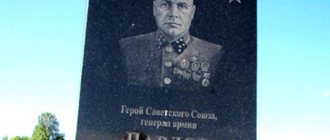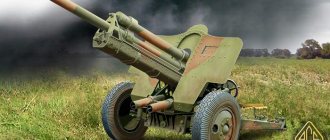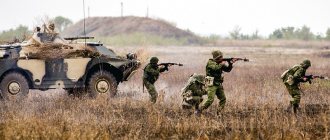In the Russian Federation, motorized rifle troops are currently the most common branch of the military, which is the “skeleton” of the entire Russian army. The motorized rifle troops of the Russian Federation are ground troops, which consist of infantry, armored vehicles and vehicles. Their main task is to participate in large-scale ground operations, and also, if necessary, to interact fruitfully and quickly with other troops.
Any structural unit of motorized rifle troops must be able to participate in battles in any weather, at any time of the day, on any day of the year and on any terrain. The main responsibility of the unit commander is to coordinate the work so that each individual soldier knows his goal and mission and has the opportunity to carry it out.
2.1. Advance of the motorized rifle battalion of the Soviet Army (eighties)
The battalion advances on a front of up to 2 km, and in the breakthrough area on a front of up to 1 km. The battalion can successfully attack a defending enemy infantry company. As a rule, a battalion builds its battle formation in two echelons or in one echelon with the allocation of a combined arms reserve. Typically, two companies operate in the first echelon and one company in the second. A battalion can operate in the first or second echelon of a regiment. A battalion operating in the first echelon of a regiment is assigned an immediate mission (usually to the depth of an enemy infantry company strongpoint), a further mission (usually to the depth of the enemy's first defensive position, and a direction of further attack, which usually coincides with the regiment's immediate mission. A battalion operating in the second echelon The regiment is assigned a line of entry into battle, the immediate task (usually at the depth of the enemy's brigade defense reserves) and the direction of further attack, which usually coincides with the further task of the regiment.
The battalion can advance from a position of direct contact with the enemy. In this case, if the battalion operates in the first echelon of the regiment, then it occupies the initial position at the first position of the regiment, and if the battalion operates in the second echelon of the regiment, then it occupies the initial position at the second position of the regiment.
The battalion can advance on the move (with advancement from the initial area). When advancing on the move, the battalion advancing in the first echelon of the regiment follows on an infantry fighting vehicle in one column to the line of deployment into company columns (4-6 km from the enemy’s front edge), in company columns to the line of deployment into platoon columns (2-3 km from the front the edge of the enemy's defense); at the line of attack (600m from the enemy’s front edge), platoon columns are deployed into battle formation. If necessary, a dismounting line is designated, where the personnel leave the infantry fighting vehicle and then move on foot. If the enemy does not offer fierce resistance, then the offensive continues from the line of transition to the attack of the platoon into the line of vehicles.
When advancing on the move, the battalion advancing in the second echelon of the regiment follows in a battalion column to the line of entry into battle, where it deploys into battle formation.
The battle formation of the advancing battalion is deliberately shown in an extremely simplified manner. It does not show the means and forces of reinforcement, support, assigned forces and means, tanks, artillery, communications equipment and many other mandatory elements of the battalion’s combat order.
Notes:
1. The second echelon is intended to develop the success achieved and increase the tempo of the offensive. He is assigned a line of entry into battle, the immediate and further tasks. 2. The combined arms reserve differs from the second echelon in that it is not assigned a line of entry into battle, as well as immediate and further tasks. It is designed to solve sudden problems (repelling counterattacks of the enemy entering the rear; changing units that have suffered heavy losses, destroying a newly identified enemy, holding captured lines, destroying residual enemy groups in the rear of advancing units.
Professional holiday
Even in this, motorized rifle troops differ from all ground forces: the official holiday of the latter is set for October 1, and Motorized Rifle Troops Day is celebrated in the summer, on August 19 .
What are the distinctive insignia of motorized riflemen? The flag looks like a black cloth, against the background of which two Kalashnikov assault rifles are crossed, surrounded by wreaths of laurel leaves. The sleeve patch looks exactly the same as the flag.
right off the bat (eighties)
(General principles)
Typically, a marching offensive is carried out by troops that secretly concentrate in their initial areas. Those troops that are in direct contact with the enemy in the offensive either do not participate at all, or later form the combined arms reserve of the senior commander.
The starting area of the advancing regiment is usually designated 20-40 km. from the front line of the enemy's defense.
At the appointed time, the regiment moves in column to the starting line. The time for passing the initial line is set with the expectation that by time “H” you will reach the front line of the enemy’s defense. In planning documents this time is usually indicated as “H-** hours”
(for example, “go to the starting point at H-2 hours”, i.e. two hours before time “H”). The time “H” is usually unknown to the regiment in advance. It is communicated to the regiment on the day of the offensive.
When planning an offensive, the time it takes to pass is calculated for each line (“H-…h…min”), and all actions after passing the front edge are planned as “H+…h…min” (for example, complete the closest task by H+3 hours 20 min., complete the further task by H+5 hours).
The head of the regiment's column must pass the starting line at exactly the appointed time.
Having reached the line of deployment into battalion columns, the regiment is divided into two columns and each battalion of the first echelon then moves along its own route. The regiment's command post moves along one of these routes at a certain distance from the battalion column. The second echelon battalion is also moving along one of these routes.
Having reached the line of deployment into company columns, each battalion of the first echelon is divided into two or three columns. And then each company moves along its own route.
Having reached the line of deployment into platoon columns, each company is also divided into platoon columns.
At the point of going over to the attack, each platoon of the first echelon is deployed into battle formation. Our defending troops allow advancing troops through their line of defense, covering their deployment with their fire and supporting the attack with fire.
By time "H" the attackers reach the front line of the enemy's defense.
The attacking units must pass each line at exactly the appointed time. The simultaneity of the attack, and therefore its success, depends on this.
Modern Russian motorized rifle forces
After the collapse of the USSR, motorized rifle military forces were formed in the Russian Federation in 1992. Since motorized rifles are distinguished by uniquely high mobility and versatility, they can perform various maneuvers in short periods of time and instantly modify tactics, alternate one type of combat with another, change the direction of movement, concentrate in a certain area of combat, or, conversely, disperse. It is obvious that motorized rifle divisions and battalions have an undeniable advantage over brigades with bulky military equipment.
(eighties)
Motorized rifle battalion defends the defense area
with a length along the front of 3-5 km and a depth of 2-2.5 km. As a rule, a battalion builds its defense in two echelons. The first echelon usually consists of two companies, and the second echelon - one company.
The battalion's defense rests on three trenches. The first and second trenches are occupied by companies of the first echelon (each of them builds its defense in two echelons), and the third trench is occupied by a company of the second echelon, which builds its defense in one echelon.
Up to 2 km away from the enemy. from the first trench, the battalion sets up a combat guard with forces up to a platoon (more often this platoon is taken from a company of the second echelon). The task of the combat guard is to timely detect an advancing enemy, inflict losses on him, and mislead the enemy regarding the location of the main forces; and also to force the enemy to prematurely deploy into battle formation. Upon completion of the assigned task, the combat guard, under the cover of fire from the main forces, withdraws and takes up defensive positions with its company or goes into the reserve of the battalion commander.
The battalion commander's control post is located at a distance of up to 2 km. from the front edge, usually at the second echelon company strongpoint.
The battalion's order of battle is presented in a deliberately simplified manner. It does not show the communication passages leading from the company's strong points to the rear, to the battalion command post; it does not show reserve and cut-off positions, infantry fighting vehicles trenches, the location of the battalion's mortar battery, the anti-tank platoon, the positions of fire reinforcements and attached tanks and artillery, obstacles, minefields , ammunition supply points, economic supply point, water supply points, battalion medical center, transportation and evacuation routes. The boundaries of the battalion's defense area and the strongholds of companies and platoons, in violation of the regulations, are drawn not in red, but in brown. This was done for the purpose of greater clarity.
Tactics and combat standards of the regiment and above are classified information and will not be published.
Development during the USSR
In the early 1940s, the very first brigades of motorized rifle troops were formed in the USSR. By the end of the Second World War, they became the largest part of the troops in the Red Army.
With the development of technology and the use of all kinds of self-propelled artillery, multiple launch rocket systems, armor-piercing and mortar launchers, etc., by 1960 a huge number of real motorized rifle units had been created in the Red Army. Soviet motorized riflemen became an exemplary example for the armies of all world powers. By 1990, the motorized rifle forces of the Red Army included 145 divisions, 450 regiments and 150 battalions.
(eighties)
A motorized rifle platoon can conduct a defensive battle, being in the first or second echelon of a company, in the combat outpost of a battalion, or in the forward position of a regiment. A motorized rifle platoon defends a strong point
length along the front up to 400m, and depth up to 300m. When performing a combat guard mission, a platoon can defend up to 500m. along the front. The platoon's battle formation consists of squad positions, which can be located in a line (all squads are located in the first trench), in two lines (the flank squads are located in the first trench, and the central one in the second trench, with a ledge to the right or left (one of the flank squads is located in the second trench, and the other two in the first).
MSV order of battle in line
The length of the squad position is up to 100 m. The distance between squad positions is up to 50 m. and for communication between them the flow of communication is broken off. From the squads located on the flanks of the platoon, communication lines to the left and right neighbors are separated. From the middle squad, the message usually goes to the platoon commander's command post and then to the rear.
For each infantry fighting vehicle, a main and reserve trench are created, with the second trench usually facing the flank or rear, and is designed to provide all-round defense for the platoon. Between the trenches for infantry fighting vehicles the distance is up to 200m. If possible, to ensure all-round defense of the platoon, trenches for squads can be opened, facing the rear and flanks of the platoon's strong point.
The platoon commander's command and observation post is located behind the squad positions at a distance of up to 50m. from the front edge. The KNP is a special form of trench and dugout with a capacity of up to one third of the platoon personnel.
MSV order of battle in two lines
Literature:
Combat regulations of the Ground Forces of the Armed Forces of the USSR (platoon-squad-tank).
Creation and becoming
Although infantry troops have been combined with various equipment since the 1900s, the name “motorized rifle troops” did not appear until 1957. The first such military formations were infantry forces equipped with combat vehicles with internal combustion engines. They took part in battles in southern Africa at the turn of the 19th and 20th centuries.
However, motorized rifle troops became truly widespread during the First World War. At that time, they were armored trucks that were used to deliver supplies and soldiers to the front line. In the middle of the war, the interaction of infantry troops and equipment began to be talked about as a full-fledged weapon. Thus, in 1916, the first developments of lightweight tanks with excellent maneuverability began to appear, and this period also marked the beginning of the creation of the first armored personnel carriers. By the end of the First World War, infantry in Russia received the name “rifle” troops. This meant that the motorization and mechanization of the army was irreversibly launched.
Armament of motorized riflemen
Soldiers of motorized rifle military forces possess a variety of weapons that can be used manually, as well as a large number of explosive supplies and armored vehicles.
Handguns
Soldiers serving as part of the MRF carry the following types of hand weapons:
- Pistols: 9mm SPS, 9mm Makarov pistol, 9mm MP-443;
- Assault rifles: 5.45 mm AP-94, 5.45 mm AK-74M, 9 mm Val;
- Rifles: 9 mm VSS, 7.62 mm Dragunov rifle;
- Machine guns: 7.62 mm Pecheneg, 12.7 mm NSV, 5.45 mm Kalashnikov;
- Grenade launchers: 30-mm AGS-30 complex, 30-mm AGS-17, hand-held anti-tank RPG-7.
Other ammunition
Motorized rifle military battalions use the following:
- Grenades: F-1, RGN, RGD-5;
- Mines: MFM-1, PMN, POI-2, OZM-72;
- Anti-tank weapons: RPG-30, RPG-28, RPG-18.
Armored vehicles
Russian MSVs have at their disposal the following types of armored vehicles:
- Armored vehicles. KamAZ-43269, BM Tiger, Lynx;
- BTR: BTR-90, BTR-82A, BTR-82AM, BTR-80A, BTR-80, BTR-70M.
- Combat infantry equipment: BMP-3, BMP-2.
